2. Mission and Aperture Synthesis Design, Optimized Time-Varying Apertures
The coherent processing of multistatic radar data acquired from a set of different aspect angles opens the door to a wide spectrum of unique radar remote sensing techniques and applications. Examples are highly accurate tomographic measurements of vegetation layers for forestry and precision farming, the acquisition of vertical snow and ice profiles for glaciological research, the observation of soil moisture and structure for agricultural and climate studies, as well as the acquisition of many further and highly relevant Earth observation parameters, such as the detection of slope instabilities and mass movements in Alpine terrain or the measurement of near-surface flow velocities over water bodies.
In the sub-project Mission Planning, the distributed observation capabilities offered by KoRaTo will be analyzed, optimized and demonstrated for a set of selected geophysical applications. In view of the various observation parameters and application domains, a series of end-to-end performance analyses and simulations will be conducted with the goal to select the most promising applications and suitable test sites and to optimize the acquisition parameters and flight trajectories. The simulated radar data will in addition be used to prepare the SAR and higher-level data processing chains and the system calibration. Dedicated flight campaigns will acquire multistatic SAR data over a set of selected test sites in a variety of drone formations. The collected data sets will be processed to higher-level information products and compared to ground-truth validation data acquired together with the flight campaigns. The goal is to explore and demonstrate the unique capabilities provided by a swarm of mutually coherent radar drones for environmental monitoring and to prepare future distributed SAR satellite systems and missions in view of emerging Earth observation applications.

Sub-Projects
Tomographic Imaging and Retrieval of Geophysical Parameters
Lead: Prof. Dr.-Ing. Gerhard Krieger, Institute of Microwaves and Photonics, FAU
This sub-project analyzes and demonstrates the capabilities of coherent drone swarms for multi-baseline SAR interferometry and tomographic 3-D radar imaging with respect to novel geoscientific applications. Each of the innovative applications requires detailed observation planning in conjunction with a dedicated processing of the multistatic radar data. Particular challenges to be resolved are the compensation of phase and motion errors, the end-to-end system calibration, as well as the development and implementation of a multidimensional signal processing chain up to the retrieval of geophysical parameters like digital elevation models and/or vertical structure profiles. In a second phase, new imaging modes like MIMO-SAR tomography and holography shall be explored as well as an extension to interferometric and tomographic time series with short and systematic repetition intervals. The work builds on the extensive experience of the German Aerospace Center (DLR) with the processing of air- and spaceborne SAR data as well as the design, operation and calibration of innovative bi- and multistatic SAR missions such as TanDEM-X.
Optimization of Wideband Multi-Static Synthetic Apertures using Compressed Sensing Methods
Lead: Prof. Dr.-Ing. Christian Waldschmidt, Institute of Microwave Engineering, UUlm
In order to achieve efficient imaging and optimal imaging quality using a mult-static radar sensor network, on the one hand the trajectories and thereby the synthetic aperture of the UAVs needs to be optimized, and on the other hand, the images of the different sub-apertures need to be skilfully merged. For this purpose compressed sensing techniques are being considered, which allow to reduce measuring effort and allows to improve imaging quality at the same time. In this context, the multi-static ambiguity function is investigated in order to derive imaging quality criteria and propose optimized flight trajectories. Furthermore, compressed sensing methods are being considered to improve image quality by reducing artifacts and clutter contribution.
